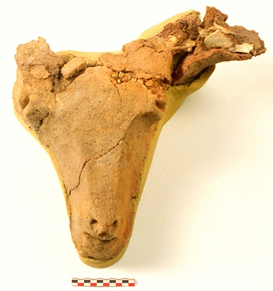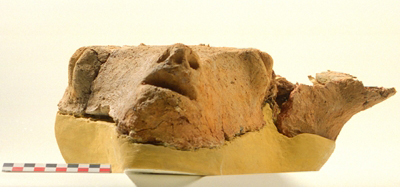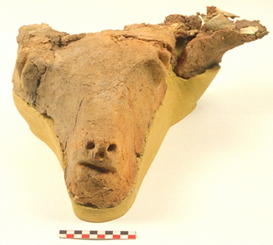 |
 This exceptional object was found in 1995 in a layer dating to the end of Late Neolithic I. It was part of a rubble heap resulting from the destruction of a house. It is a real ox skull, covered with raw clay that reproduces the animal’s features in low relief. The shape is roughly triangular, the horns are broken near the base and the back side is flat; the eyes, nostrils, and mouth are shown by grooves and cavities. This exceptional object was found in 1995 in a layer dating to the end of Late Neolithic I. It was part of a rubble heap resulting from the destruction of a house. It is a real ox skull, covered with raw clay that reproduces the animal’s features in low relief. The shape is roughly triangular, the horns are broken near the base and the back side is flat; the eyes, nostrils, and mouth are shown by grooves and cavities.
This object of course brings to mind the much older bulls’ heads from Çatal Hüyük, which are shaped using raw clay applied to real horns and suspended on walls. It is even more reminiscent of the few ox heads known from Neolithic sites in the central Balkans (Hungary, Serbia, Romania), although the latter are sometimes made only from clay, i.e. without a skull underneath. In addition, these are later in date than the Dikili Tash specimen, which thus remains unique in the southern Balkans.
|
 |
The frequency of the ox head’s motif, from Near East to Europe, has naturally led to the supposition of an almost universal bull cult and the identification of sanctuaries in a great number of sites. But this assumption has never been confirmed: the presence of the same image in more than one site does not imply that they always shared the same symbolic meaning. As far as the bucranium of Dikili Tash is concerned, it is certain that it was placed in a vertical position on an internal support or a wall of the house (in the way shown on a house- model discovered in Promachon/Topolnitsa), or possibly on a post. It recalls the hunting trophies of all periods that ultimately become mere decorative objects. Its precise significance remains unclear, however. |